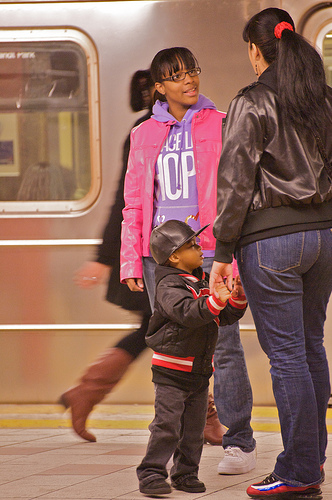Congestion Pricing Can Help Save Working NYC Families $2,300 Per Year
 Without congestion pricing, fare hikes will hit New York’s many transit-using families hard. Image: Ed Yourdon via Flickr.
Without congestion pricing, fare hikes will hit New York’s many transit-using families hard. Image: Ed Yourdon via Flickr.Without bold action from legislators to fund transit, middle-class New York families will have to spend $2,300 more per year
to get around the city even as the quality of the service they’re
paying for declines, according to a new analysis released today by John Petro of the Drum Major Institute.
The choice for policymakers, Petro writes, should be clear: Congestion pricing could raise $420 million in new annual revenue, enough to close most of the MTA’s current budget deficit and spare working New Yorkers the brunt of painful fare hikes and service cuts.
DMI is a progressive think-tank based in New York City with an explicit focus on middle class issues. Today’s report puts the economic and equity impacts of congestion pricing front and center. If the MTA tries to balance its budget with only service cuts and fare hikes, Petro estimates that a transit-dependent family of four will be forced to spend an additional $2,300 a year to get around the city.
Fully 55 percent of New Yorkers commute to work via transit. In contrast, only five percent commute into the CBD by car, and they are disproportionately affluent [PDF]. "One of the most frustrating arguments against congestion pricing is that it would disproportionately hit the middle class," said Petro. "It’s frustrating because it’s so plainly untrue." The DMI report makes a strong case for why congestion pricing is exactly the kind of policy that supports New York’s middle class.
What’s more, Petro argues, congestion pricing would be the most fiscally and environmentally responsible way to fund the MTA. Congestion pricing wouldn’t force the MTA to raid its capital budget just to keep buses and trains running and would also take 100,000 cars off the road, improving bus service for millions and reducing both greenhouse gas emissions and asthma-causing air pollution.
The MTA needs to balance its budget, one way or the other. Congestion pricing offers a fiscally sustainable and socially equitable revenue stream with major environmental benefits. That said, Petro’s numbers show that the MTA’s $783 million deficit — caused principally by declining revenues and shrinking government funding — can’t be closed solely with the $420 million that Mayor Bloomberg’s 2007 congestion pricing plan was projected to raise per year.
The details of the plan could be tweaked, however. "Some form of congestion pricing could be created to raise enough revenue to close the gap, if that’s what the goal is," Petro said. If Albany gets its act together, could congestion pricing be passed quickly enough to avert the current crisis? Petro believes it’s possible, although to get the money in time for this budget cycle, he says the MTA will have to take out an expensive short-term loan.
That’s a small price to pay when the alternative is to collect $2,300 more in fares from every transit-riding family of four in New York City. "If another source of revenue is not found, that is what we’re looking at," said Petro.